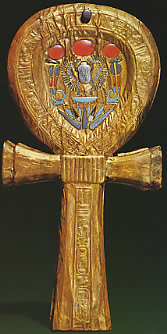
- Ankh -

Ankh is the modern reading of the Ancient Egyptian hieroglyph ![]() , anx, which represents a part of a sandal: the rounded top of the symbol is the loop that goes around the leg, the two "arms" of the symbol go to the sides of the feet and the longer "body" of the symbol goes from the leg to between the toes.
, anx, which represents a part of a sandal: the rounded top of the symbol is the loop that goes around the leg, the two "arms" of the symbol go to the sides of the feet and the longer "body" of the symbol goes from the leg to between the toes.
For some reasons, the Egyptians called that part of the sandal anx (exact pronunciation unknown). Because this word was composed of the same consonants as the word "life", the sign to represent that particular part of the sandal, was also used to write the word "life". The Ankh-sign used to write "life" is a phonogram, a sign used for its phonetic value. It then became so associated with the concept "life", that one might have the impression that it was exclusively used to write the word "life".
The hieroglyphic sign Ankh also became the symbol representing the concept of life. Often, one will encounter a picture of a god holding a long sceptre in one hand -for male gods this is called the "Was"-sceptre and it represents "authority"- and the Ankh sign in the other.
Other representations show a god or goddess holding the Ankh in front of the king's nose. Life was breathed in through the nose. A common plea from Egypt's defeated foes to the king was "do not take away the breath of life from our noses". This makes the gods and the king the ultimate dispensers of life in Ancient Egypt.

An Ankh-shaped mirror box found among the many treasures in Tutankhamun's tomb. It is just one of the many examples of Ankhs found in Egypt.